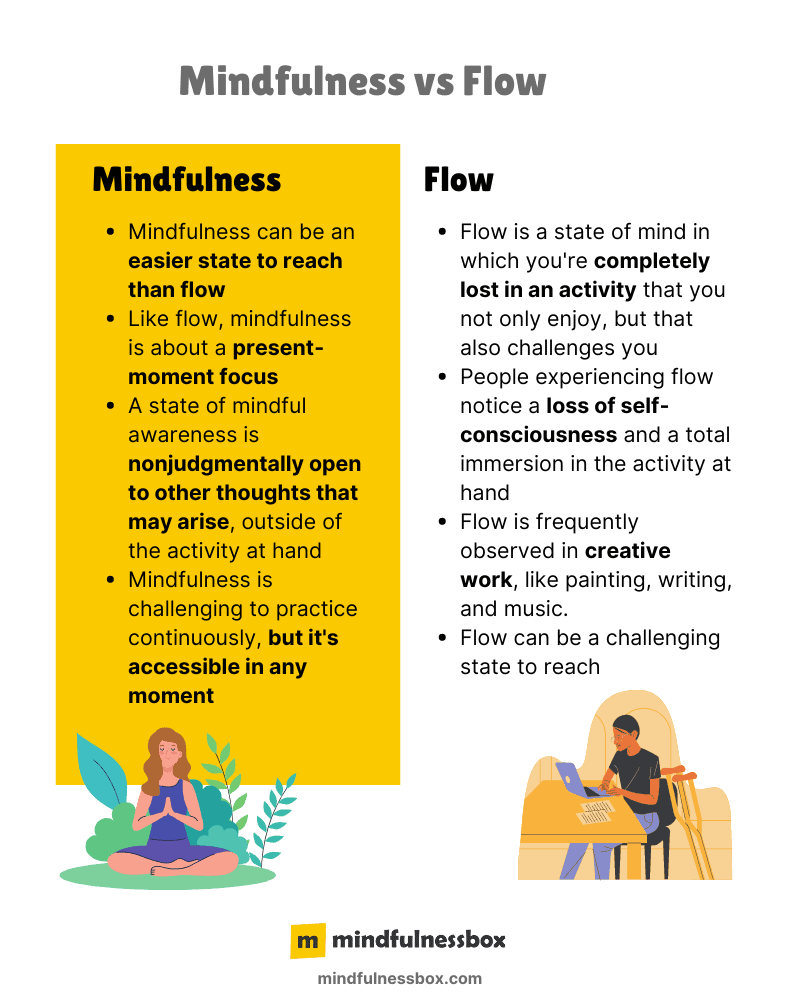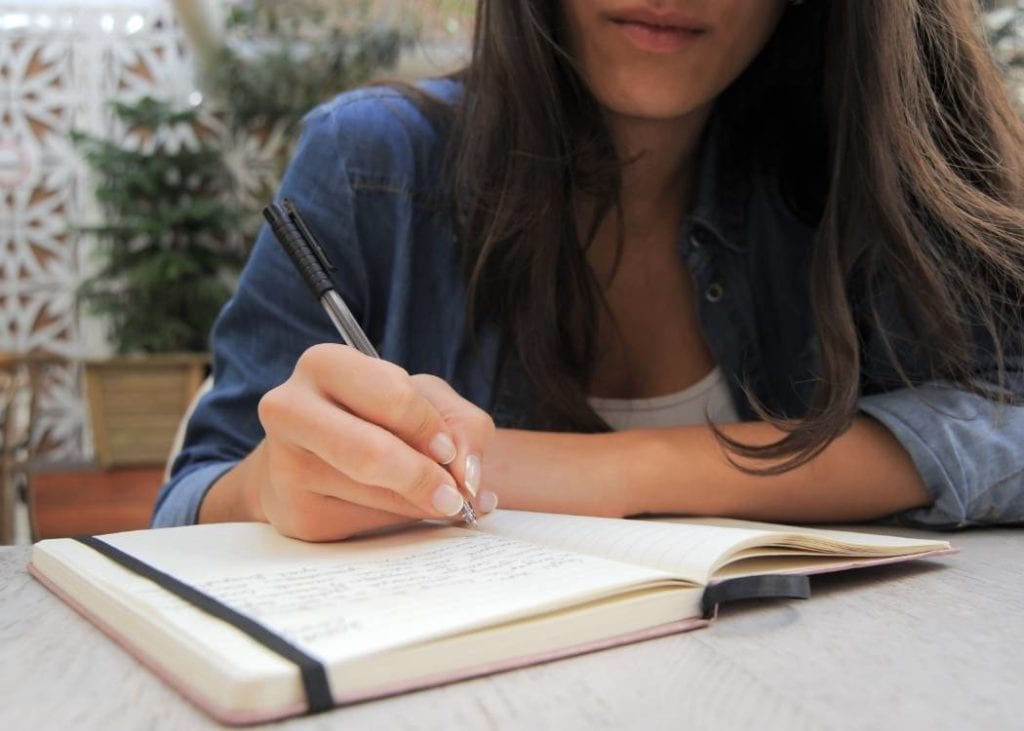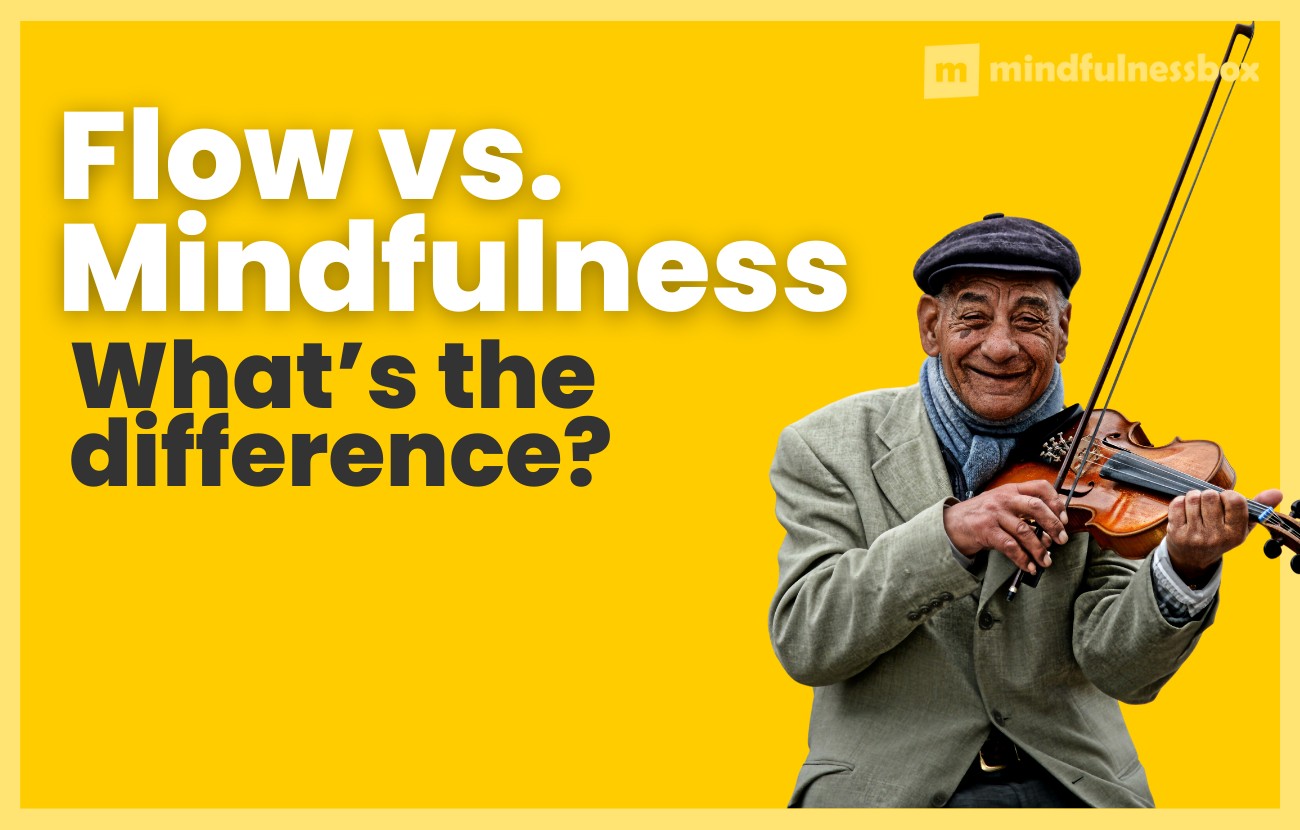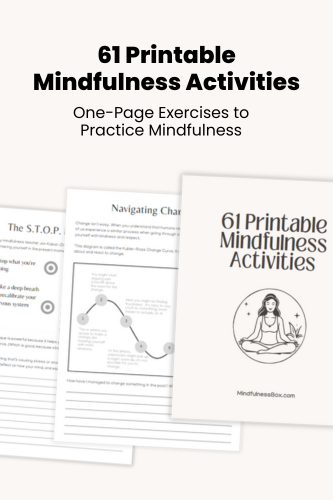The main difference between mindfulness and flow is that mindfulness requires that you maintain awareness, while flow requires you to become immersed in an activity.
Flow is a state of mind reached when you’re entirely immersed in an activity, to the point where you may lose track of time and forget yourself. Mindfulness, in contrast, is a state of mind where you are aware of your thoughts and activities and observe them without judgment.
While both activities feature a focus on the present moment, flow tends to result in a complete immersion in the activity itself, while with mindfulness you maintain awareness.
Get dozens of one-page exercises to help practice mindfulness, meditation, gratitude, and self love. Perfect for printable handouts when teaching mindfulness to groups, students, or in the workplace.
To see examples, plus a full list of the 61 exercises included, click below.
If you’re looking to improve your performance, productivity or concentration, it’s worth understanding the similarities and differences between mindfulness and flow.
This article will compare the two concepts, as well as provide some examples on how each might show up in your daily life.
Examples of mindfulness vs flow

Let’s dive deeper by looking at a couple examples of mindfulness and flow.
1. Examples of Flow
Flow is a state of mind in which you’re completely lost in an activity that you not only enjoy, but that also provides a level of challenge.
Take sports, for example, where it’s sometimes known as being “in the zone”. Flow has commonly been observed athletes who become immersed in competition.
While experiencing this state, “the athlete loses self-consciousness, time seems to move much slower, and the athlete has elated feelings of self-accomplishment.” Flow is observed in creative work, too, like painting, writing and music.
2. Examples of Mindfulness
With mindfulness, participants are also focused on the activity and hand and take care to stay in the present.
However, rather than being lost in the activity, with mindfulness you maintain a level of consistent, nonjudgmental awareness—not only of the activity, but of your thoughts and the surrounding environment.
An example of mindfulness is stopping to appreciate the present moment by observing things around you that you’re grateful for. Mindfulness has been called “the more accessible cousin of flow.”
Flow tends to be a more challenging state to reach, requiring uninterrupted focus on work that is both challenging and enjoyable, and may show up more commonly as participants are more experienced. Mindfulness, on the other hand, may be challenging to practice continuously, but is accessible in any moment.
Is flow the same as meditation?
Flow is not the same as meditation.
It’s possible for practitioners of meditation to reach a state that may feel similar to flow, in the sense of being immersed in an activity, losing self-consciousness and losing track of time.
However, the goal of open awareness meditation techniques is to observe your wandering thoughts without judgment, and bring them back to the present moment.
While both meditation and flow feature a focus on the present moment, flow tends to result in a complete immersion in the activity itself, while meditation maintains a level of meta-awareness throughout.
Flow feels perhaps more similar to concentration meditation techniques, which rely on the practitioner maintaining awareness on a single object or activity.
However, the difference remains that with meditation, your goal is to never lose awareness, whereas in a state of flow, you’re immersed in an activity and lose yourself in it.
Can mindfulness and flow happen together?
Research published in 2014 covers the connection between mindfulness and flow.
As it turns out, they might be difficult to experience at the same time due to conflicting goals: maintaining self-awareness (mindfulness) versus losing self-awareness within an activity (flow).
“Mindfulness involves cultivating an observer of consciousness, trying to maintain reflective awareness of each moment. In contrast, flow involves losing the inner observer within an altered state of consciousness in which the moment blurs into a continuous stream of activity.”
The research team designed a study involving 272 participants and the flow-inducing computer game Tetris. They found results indicating that mindfulness might actually negatively impact flow.
“Intuitively, mindfulness and flow seem to go together… We found evidence for the opposite conclusion: that boosting a person’s ability to remain mindful during an activity might actually undermine their ability to get absorbed in that activity.”
Interestingly, the authors of the study also concluded that “mindfulness and flow can come and go in potentially rapid succession, such that although they rarely occur simultaneously, they can both take place quite often within a particular period of time.”
Applying mindfulness and flow to daily life

When comparing mindfulness and flow, you might be thinking about how to enhance concentration, productivity, or enjoyment of activities.
Let’s take the example of writing, and see how mindfulness and flow might apply.
Remember, mindfulness is “the more accessible cousin of flow.” So let’s take advantage of that, and start our session with mindfulness, then ease into flow.
Mindfulness would start at the beginning of the writing process.
First, you might set an intention for the writing session. For example, what’s the goal you’re aiming for with this session? What energy do you want to maintain?
Let’s say your goal is to write for two hours, with a joyful, light energy. As you get distracted during the writing process—perhaps going down rabbit holes on the internet instead of writing—you resolve to gently pull yourself back to the task at hand.
If you start to feel heavy, frustrated feelings around the writing session, you’ll nudge yourself back to your original intention of joy.
Flow may or may not make an appearance during your writing session—even if you’re an experienced writer, in a state of positive energy, and writing about something you’re passionate about.
But sometimes flow does show up, typically after you’ve already gotten “in the groove” and achieved some momentum in your writing session. You’re immersed in the activity, and the words seem to flow onto the page much more smoothly than they did at the start.
A flow-like state is one reason writers are encouraged to separate writing and editing as separate processes. One is all about inspiration and getting thoughts down onto the page. The other is all about details and double-checking, which slows momentum and pulls you out of the experience.
Flow and mindfulness can both help concentration, but they may show up at different times during a writing session. Which are you experiencing? If you have to remind yourself to come back to the task at hand, you’re probably experiencing mindfulness. If the words are flowing much faster and easier than normal, you’re probably experiencing a state of flow.
What is mindfulness-in-flow?
A 2017 study described a flow state termed mindfulness-in-flow, or mindflow.
Examples of this type of flow are “walking meditation, gardening and calligraphy,” but it can also occur in “ordinary activities such as driving a car.”
Mindfulness-in-flow is perhaps the closest intersection of mindfulness and flow.
In this state, the practitioner is highly absorbed in the activity at hand, but also maintains a full awareness on the experience and environment around them.
Mindfulness and flow are different—but complementary
Mindfulness and flow aren’t the same, nor are meditation and flow.
However, mindfulness and flow may show up at different times during the same activity, and both can be desirable states.
Mindfulness, the “more accessible cousin of flow,” is often the best place to start, because it’s more within your control.
This is especially true if you’re practicing an activity you’re not particularly experienced at.
A state of flow is more likely to show up once you’ve gotten more practice at the task at hand. But mindfulness can help keep your attention on the task at hand for long enough for a state of flow to arrive.
Whether you’re looking for improved concentration, productivity or performance, it’s worth learning more about both mindfulness and flow so you can actively look for and encourage them in your day-to-day life.
Further reading
For more on mindfulness, focus, and productivity, check out these articles:

My mindfulness practice kicked off in 2016 with a ten-day silent retreat. Since then, I’ve read dozens of books about mindfulness and completed hundreds of hours of meditation. Thinking about what makes humans happy, calm, and peaceful is endlessly fascinating to me.


